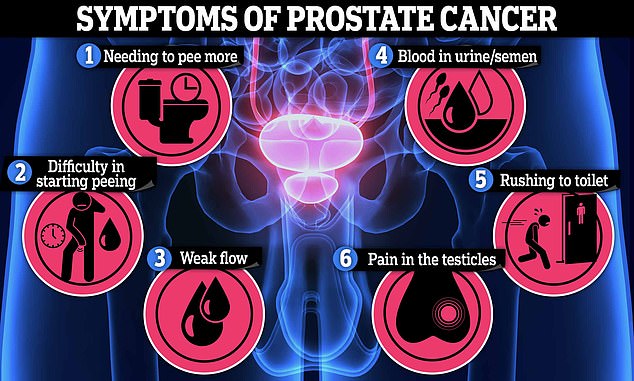Table of Contents
OJ Simpson, the prominent football player accused of killing his wife in the 1990s, has died at age 76 after a brief battle with prostate cancer.
The disgraced football star announced he was diagnosed with prostate cancer just two months ago, suggesting the cancer was at an advanced stage.
Prostate cancer is the second most common form of cancer in men, only behind skin cancer.
Experts estimate it will affect 300,000 American men this year and kill more than 35,000, most of whom are over 65, and the American Cancer Society (ACS) says rates are rising about three percent each year. .
Additionally, health care providers warn that the disease can be difficult to detect, as it often causes no symptoms at first. The signs usually reflect those of an enlarged prostate, which tends to affect older men.
This could cause it to spread rapidly to the bones and organs such as the lymph nodes, lungs, liver, and brain.

OJ Simpson was announced that he was diagnosed with prostate cancer just two months ago, suggesting his cancer was at an advanced stage.


The retired footballer was infamously tried in 1995 for the deaths of his ex-wife Nicole Brown Simpson and his friend Ronald Goldman. He was eventually acquitted.
Read on to learn everything you need to know about prostate cancer:
What is prostate cancer?
Prostate cancer forms from cancer cells in the prostate, a walnut-sized organ found only in men.
Located between the base of the penis and the rectum, the prostate produces fluid that mixes with sperm to help them travel and survive.
The urethra, which is the tube that carries urine and semen out of the body through the penis, runs through the center of the prostate.
According to the ACS, almost all prostate cancers are adenocarcinomas, which form from mucus-producing glands in the body.
In prostate cancer, these develop from cells that produce prostatic fluid that is added to semen.
What causes prostate cancer?
Doctors aren’t entirely sure what causes prostate cancer, although they have identified some risk factors.
Older men are the group most likely to develop the condition. The ACS estimates that 60 percent of prostate cancers are found in men over 65 years of age.
However, many in this group could also be experiencing symptoms due to an enlarged prostate rather than prostate cancer.
Prostate enlargement, which has affected famous men such as King Charles III, usually affects patients over 50 years of age. More than 90 percent of cases occur in men over 80 years of age.
Doctors suspect this is due to hormonal changes as men age.
African American men have a higher risk of developing cancer, having it spread, and being diagnosed before age 50.
In some cases, genetics could be to blame. Mutations in the BRCA1 and BRCA2 genes, for example, have been linked to increased risks of prostate, breast, ovarian, and pancreatic cancer, among others.
Other risk factors include smoking, obesity, sexually transmitted infections, genetics and exposure to Agent Orange, a chemical used during the Vietnam War.
What is the prognosis and how did orange juice decline so quickly?
Although prostate cancer is common, it usually responds well to treatment if caught early.
Cases that remain confined to the prostate and surrounding organs have a 99 percent survival rate, according to the National Cancer Institute (NCI).
However, because prostate cancer often causes no symptoms at first, it can be difficult to identify before it spreads.
In the later stages, the survival rate drops to 34 percent.
OJ’s death just two months after announcing the illness suggests he may have been diagnosed at a later stage. This means that it would have spread beyond the prostate and surrounding tissues and would have traveled to the bones.
When cancer spreads to the bones, it most often affects the bone around the spine, as well as the pelvis, upper leg bones, ribs, and skull.
How is prostate cancer treated?
There are several treatments for prostate cancer.
One is prostatectomy, a minimally invasive surgery to remove all or part of the prostate gland and eliminate the cancer from the body. There are two minimally invasive prostatectomy procedures: laparoscopic surgery and robot-assisted surgery.
These procedures involve making several small incisions that doctors use to insert surgical tools and a camera to view the surgical field.
In a laparoscopic procedure, doctors use a tool with a long handle while viewing magnified images from a camera on a video screen.
In robotic-assisted prostate surgery, doctors use a specialized robotic system to make small incisions in the patient’s abdomen that allow surgeons to access the prostate.
What are the symptoms of prostate cancer?


Prostate cancer is one of the most common forms of the disease, affecting 300,000 American men each year. It is more common in people over 50 years of age and in black men.
Prostate cancer usually causes no symptoms in its early stages.
However, ACS states that early warning signs include problems urinating. This could include needing to urinate more frequently, especially at night, or having a slow or weak stream of urine.
It may also be difficult to start urinating or men may feel like their bladder has not emptied completely.
You may also find yourself running to the bathroom with an increased need to urinate.
As the disease progresses, people may develop painful urination, loss of bladder and bowel control, painful ejaculation, and erectile dysfunction.
Additionally, patients may experience pain in the testicles.
More advanced prostate cancer can also cause blood in the urine or semen.
How common is prostate cancer and why are rates rising?
Prostate cancer is the most common cancer among men after skin cancer.
The ACS estimates that one in eight men will develop prostate cancer during his lifetime.
Also according to the ACS, there will be about 300,000 new cases of prostate cancer this year, along with 35,250 deaths.
While cases decreased between 2007 and 2014 due to updated guidelines that reduced the number of men being screened, the incidence rate since 2014 has increased about three percent per year, the ACS estimates.
And the increase in late-stage prostate cancer has increased by five percent.
In a report in the ACS journal Cancer Statistics, researchers wrote: “The increasing percentage of men developing advanced prostate cancer, which is much more difficult to treat and often incurable, is very discouraging.”
“To end cancer as we know it, for everyone, it is imperative that we focus on cancers whose incidence and mortality trends are heading in the wrong direction.”
Experts have attributed the rise to a growing population of older men, among whom the condition is more common.
They have also suggested that this may be due to recent recommendations against prostate cancer screening.
In 2018, the U.S. Preventive Services Task Force (USPSTF) of the Centers for Disease Control and Prevention (CDC) presented guidelines stating that men over age 70 “should not be screened.” of prostate cancer routinely” if they are at average risk and not having no symptoms.
The agency also said that men ages 55 to 69 “should make individual decisions about whether to undergo prostate cancer screening.”

